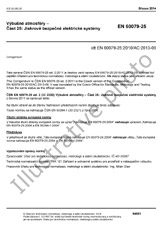We need your consent to use the individual data so that you can see information about your interests, among other things. Click "OK" to give your consent.

CISPR/TR 30-2-ed.1.0
Test method on electromagnetic emissions - Part 2: Electronic control gear for discharge lamps excluding fluorescent lamps
STANDARD published on 24.8.2012
The information about the standard:
Designation standards: CISPR/TR 30-2-ed.1.0
Publication date standards: 24.8.2012
SKU: NS-116212
The number of pages: 11
Approximate weight : 33 g (0.07 lbs)
Country: International technical standard
Category: Technical standards CISPR
The category - similar standards:
Annotation of standard text CISPR/TR 30-2-ed.1.0 :
CISPR/TR 30-2:2012(E), which is a technical report, details with the aid of reference luminaires, an independent method by which the radio disturbance characteristics of built-in electronic control gear for discharge (excluding fluorescent) lamp luminaires with protection classes I and/or II may be compared against the requirements of CISPR 15. The scope of the part is limited to electronic lamp control gear with an output power (lamp power) up to and including 150 W. Independent electronic lamp control gears are not covered by this technical report; they are within the scope of CISPR 15. This first edition of CISPR/TR 30-2 is published in conjunction with CISPR/TR 30-1. Each part of CISPR 30 series is independent and describes the test set-up for electronic control gear use together with a special lamp family.


 Cookies
Cookies
